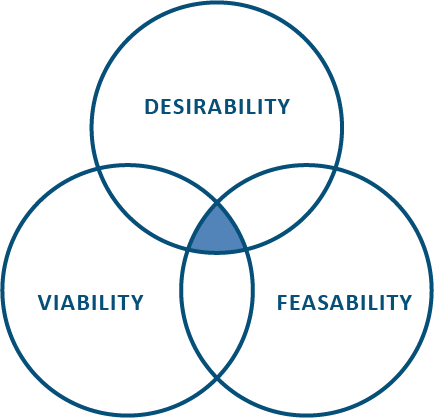How to Validate Your Business Idea Feb 28, 2024
If you’re reading this, chances are you have an idea (or 10!) for a business, but you’re not sure the best place to start. Before sinking money, time, and resources into a venture, you want to ensure that it’s one worth pursuing.
Our aim today is to give you a better understanding of how to test and validate your business ideas.
After reading, you’ll come away with:
– an innovative perspective on how to validate your business ideas
– a proven framework to rapidly design your business and test your offering in real life
– resources to help you take action today
Ready? – Let’s get validating!
Desirability, Feasibility, Viability
When it comes to assessing a business idea’s value, most entrepreneurs tend to focus on the market demand itself. Yes, market demand is important, but so are the internal capacities and capabilities of your company, and the financial viability of your business’ operations.
This is why we encourage entrepreneurs to consider these three elements:
– Desirability
– Feasibility
– Viability
These are fundamental areas that need to be explored, and they leverage design thinking (a human-centered approach to innovation) to determine if your idea is worth pursuing.
It considers the risks of your idea while also exploring what’s possible from a human, technological, and economical point of view.

IDEO U defines these categories as:
Desirability – What makes sense to and for people? Do they want what you’re offering?
This is the human element which assesses the risks associated with market size, demand now and in the future, customer retention strategies, and your ability to reach and acquire new customers.
Feasibility – What is technically possible in the foreseeable future? Can you actually do what you’re setting out to do?
The technical lens that has you consider the risks with managing, scaling, and ensuring you have key resources and partners on board to conduct successful operations.
Viability – What is likely to become part of a sustainable business model? Should you do it?
Lastly, the economical aspect has you consider risks around cost structure, revenue streams, etc. The business must make sense financially!
By looking at these three categories, you can get a better understanding of your business idea, how it can fit into your potential customers lives, and figure out if it’s worth pursuing.
Asking a couple of quick questions is great and all, but it will take a more thorough analysis. This is where a Business Model Canvas can help you, as it dives deeper into each of the categories mentioned above.
Business Model Canvas
The Business Model Canvas is a terrific business planning tool when you’re first starting your business or bringing a new product to market. Oftentimes, entrepreneurs get caught up in their idea and fail to get it out onto paper to look at in an objective way.
When they are told to write a business plan, they then get overwhelmed with filling in all the details of a 20+ page document.
There is a space in between, and that’s leveraging a Business Model Canvas while you continue to interact with your ideal customers. Doing so allows you to bridge the gap between your idea and the very real needs of your potential customers.
In this way, you can quickly adjust and pivot your canvas to ensure you’re creating a product/ service that your customers are delighted for. Nothing is worse than dreaming up an amazing idea that you think everyone will love, only to invest a bunch of money and time and have nobody buy what you’re offering.
Testing your ideas: Go from 0-1 instead of 0-100
David Bland, author of Testing Business Ideas, often asks himself, “What’s the next best test?”
You must consistently be thinking about your ideas, and how to turn them into strategic questions that can be tested so you can move the needle.
To go from idea to action can cause a lot of distress for entrepreneurs, often because the action they think they need to take is so grandiose. This is why it’s helpful to shrink down what you’re trying to do.
Rather than ditch your 9-5 to launch a full-fledge consulting business, can you test your offering on a smaller select group in exchange for feedback?
If you’re wanting to launch a new food/beverage product but aren’t sure if the industry is moving in the right direction, maybe you can spend an hour doing some secondary market research, rather than spending your time and budget into product R&D.
Instead of launching a full-service restaurant, have you thought about testing your idea as a pop up, food truck, or start in a commercial kitchen?
If you’ve got a digital product (ebook, course, etc) you want to offer but are unsure of demand, could you make a landing page and run a short ad to test website visits, click-through rates, etc., before actually making the product?
It’s also important to note that there are various aspects of your business idea that you need to test, that go beyond simply how your customer likes it.
There are also tests you can run in the “company” category. These tests help you identify opportunities for improvement with your company’s internal processes, capabilities, and capacities.
Then, there is the “competition” category, where you might consider scenarios of new products coming to market, or what might happen if they create a new product that mimics yours after your launch.
We’ve included a table below with examples in each of these three categories: Customers, Company, and Competition.
As you move along your business journey, you’ll continuously have to be testing various aspects of your business. These tests will range in size, cost, duration, and capacity. When just starting, more often than not you can collect just enough data to get started, all by yourself and with a few dollars in your pocket.
Wherever you are right now, ask yourself what’s the next best test you can run.
Here is a table of example tests that you could run depending on your business needs.
| Type of test | Low-cost & fast | Moderate cost & time | Higher cost & longer |
|---|---|---|---|
| Customers | Interviews Feedback sessions of customers interacting with prototype | Landing pages Create sessions with customers | In-market pilot programs Ad campaigns to test click through rates |
| Company | In-house observations Internal feedback meetings | Collaborative process development sessions Detailed financial overview and projections | Build out new processes and test with full team as trial |
| Competition | Role playing competitors. Reviewing competitor customer reviews, testimonials, and feedback. | Secondary market research (hey, we can help!) Shop at a competitor | Longer and more detailed primary market research of competitors |
Summary
Hopefully with the information and steps provided in this article, you feel more confident in your ability to test your business idea.
By considering the desirability, feasibility, and viability of your business idea, you increase your chances of that idea being one that actually serves a real need while knowing that you can actually deliver it.
By constantly asking yourself what’s the next best test you can run in the categories of Customers, Company, and Competition, you create a dynamic process that allows you to create product-market fit.
The beauty with this framework is that it is never ending. It is an ever-evolving, iterative process.
The tests you run to get your idea into reality, will be different that how you turn those real products and services into more optimized versions of themselves.
Some parting advice: Strive for progress during this process, not perfection.
You don’t want to fall into the analysis paralysis trap where you begin to second guess every decision.
Your potential customers/key stakeholders are the most important thing here – not your idea. You need to love the problem you’re solving more than your proposed solution. Doing so allows your solution to adapt and evolve, ultimately leading to happier customers.
Your goal is to leverage all the feedback you’re collecting into more remarkable solutions. Which just means more tests 😉
For personalized support on starting your Manitoba-based business – submit a Business Information Request
Additional Resources:
– Business Model Canvas
– Value Proposition Canvas
– The Importance of a Business Plan – Part 1
– The Importance of a Business Plan – Part 2
– Webinar – The Importance of a Business Plan

This article was written by Paul Keefe.
“As a WTC Winnipeg Business Advisor, I’m happy to help in any way I can. Don’t hesitate to reach out for guidance on your business journey, challenges, or any related matters.”



